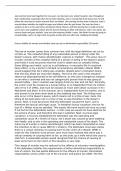Jane and Ian have lived together for two years. Ian has been very violent towards Jane throughout
their relationship, especially when he has been drinking. Jane is scared that if she leaves Ian, he will
follow her and may be violent towards their son Bobby. One evening Ian has been at the pub. Jane is
worried about whether he might be angry and violent when he gets home. She sees Ian from a
window as he is on his way home, kissing her friend, Sharon, and then leaving her to walk on home
on his own. Jane suddenly realises that he may be having an affair with Sharon, and is very upset. Ian
returns home and goes upstairs. Jane sees him entering Bobby’s room. She thinks he may be going to
assault Bobby, and is so angry that she grabs a knife and runs after him, stabbing him fatally.
Discuss liability for murder and whether Jane can rely on diminished responsibility (20 marks)
The law of murder comes from common law, with the legal definition set out by
LJ Coke as “the unlawful killing of any reasonable person in being under the
Queen’s peace, with malice aforethought, express or implied”. The actus reus of
murder consists of the unlawful killing of a person in being in the Queen’s peace,
and firstly it must be proven that the victim’s death was an unlawful killing.
Some killings are lawful, such as in self-defence, in necessity (Re A conjoined
twins 2001), or by a doctor in limited circumstances (Airedale v Bland 1993). I
would suggest that Ian’s killing was unlawful, despite Jane’s motivation being
that she was afraid Ian may harm Bobby. The force she used in this situation
seems too disproportionate to be self-defence, as she uses a dangerous weapon
on Ian who is unarmed and has not categorically proven that he was going to
assault bobby – Jane’s reaction was largely driven by fear and not fact. Secondly,
the victim must be classed as a human being, so is independent from its mother
(AG ref no 3 of 1994), and must be classed as ‘brain stem dead’ as shown in R v
Malcherek and Steel. In this scenario, Ian is independent from his mother, and is
also proven to be brain stem dead as the stabbing was fatal. The killing must
also occur in the Queen’s peace, which means not in a time of war. Here, the
killing of Ian took place not in a time of war so was therefore in the Queen’s
peace. Next, it must be proven that the defendant caused the harm, and is
therefore the factual and legal cause. To establish factual causation, the but for
test (R v White) must be satisfied. This means the harm would not have occurred
if not but for the defendants actions – in this case Ian would not have died but for
the actions of Jane, and therefore this test is satisfied. Next, to prove legal
causation, it must be established the defendant was the operating and
substantial cause (R v Smith) of injury. Ian’s death was caused by Jane stabbing
him fatally, and so she is the operating and substantial cause of his death. The
mens rea of murder is malice aforethought, which has been interpreted to mean
the intention to kill or cause GBH (R v Vickers). The defendant must also realise
there is a virtual certainty of causing harm to the victim (R v Woolin 1999) in
order for this intention to be proven. Jane must have realised that there was a
virtual certainty of causing harm to Ian, as she picks up a knife which she uses to
stab him. A reasonable person would recognise that the chance of causing at
least some harm to the victim in this situation is very high.
The charge of murder may be reduced to the offence of voluntary manslaughter,
if the defendant satisfies the requirements of either diminished responsibility or
loss of control, the two partial defences for the offence of murder. Diminished
responsibility comes under s.52 of the Coroners and Justice Act 2009. The first




